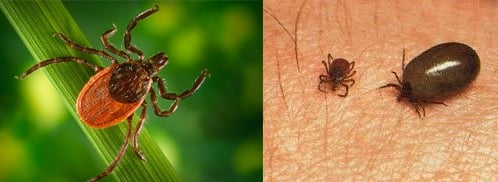Lyme disease, also known as Lyme borreliosis, is a bacterial illness that can be transmitted to humans, dogs, and other animals by certain species of ticks. It is caused by the spiral-shaped bacterium Borrelia burgdorferi that is carried inside a tick and gets into a dog or person’s bloodstream through a tick bite. Once in the bloodstream, the bacteria can travel to different parts of the body and cause problems in specific organs or locations, such as joints, as well as overall illness.
The ticks that carry Lyme disease are especially likely to be found in tall grasses, thick brush, marshes, and woods — waiting to latch onto your dog when he passes by. A tick can transmit the disease once it has been attached to a dog for 24 to 48 hours.
First named when a number of cases occurred in Lyme, Conn., in 1975, the disease can be hard to detect and can cause serious, ongoing health problems in both dogs and people.
Although Lyme disease can occur nearly anywhere in the U.S., infection risk is low in some regions and high in others. The areas of highest occurrence are the Northeast, the Upper Midwest, and the Pacific coast.
Ticks don’t jump or fly; they can only crawl. They get onto their host by waiting at the tips of vegetation. When a dog or person brushes against a bush, for example, the tick quickly grabs on and then crawls to find a place to bite.
What are the symptoms of Lyme disease in dogs?
Lyme disease is, unfortunately, a fairly common canine disease. Typical symptoms in dogs include:
- Fever
- Loss of appetite
- Reduced energy
- Lameness (can be shifting, intermittent, and recurring)
- Generalized stiffness, discomfort, or pain
- Swelling of joints
Symptoms can progress to kidney failure, which can be fatal. Serious cardiac and neurological effects can also occur.
How are dogs tested for Lyme disease?
Your veterinarian can perform blood tests to check your dog for Lyme disease and examine him for any possible symptoms. There are two types of blood tests: one is an antibody test, which detects the presence of specific antibodies that are formed in the dog’s body in reaction to the bacterium. A positive test result confirms that the dog was exposed to the bacterium.
However, dogs who were recently infected might not have a high enough level of antibodies present in their bloodstream to show up on the test. Likewise, dogs who have been infected for a long time may no longer have enough antibodies present to show a positive test result. So, there can be “false negative” test results for dogs who do indeed have Lyme.
The second type of test is a polymerase chain reaction (PCR) test, a specific DNA test that confirms the presence of the disease-causing bacterium. Again, false negative test results can occur, as the bacteria might be present in an affected joint, for example, but not in the blood cells that were tested.
How is Lyme disease treated?
Treatment includes administration of an antibiotic, usually for several weeks. This often resolves symptoms quickly, but in some cases, infection will persist and prolonged medication may be needed. Treatment can also include other therapies aimed at resolving or relieving specific symptoms.
Can I catch Lyme disease from my dog?
Dogs are not a direct source of infection for people. Lyme disease can’t be transmitted from one pet to another, nor from pets to humans, except through tick bites. However, a carrier tick could come into your house on your dog’s fur and get on you.
If your dog is diagnosed with Lyme disease, you and any other pets have probably been in the same outdoor environment and may also be at risk, so it is a good idea to consult with your physician and veterinarian to see whether you should test other pets or family members.
Other canine diseases carried by ticks
Ticks can also carry several other less common but serious bacterial diseases affecting dogs, including anaplasmosis and babesiosis.
Anaplasmosis can involve symptoms similar to those for Lyme disease. Babesiosis can present with a wide range of symptoms, from sudden and severe shock, high fever, and dark urine to a slowly progressing infection with more subtle clinical signs. Diagnosis of both diseases includes blood tests similar to those used to check for Lyme disease.
Sometimes, dogs and people can become sick with “co-infection” of multiple tick-borne diseases, where more than one type of disease-causing bacteria is transmitted through a tick bite. This situation can make diagnosis and treatment even more challenging and difficult.
How can I prevent my dog from getting Lyme disease or other tick-borne illnesses?
Recommendations on preventing ticks include these from AKC’s Chief Veterinary Officer Dr. Jerry Klein:
- Inspect your dogs and yourself daily for ticks after walks through the woods or grassy settings. On dogs, look especially on the feet (and between toes), on lips, around eyes, ears (and inside ears), near the anus, and under the tail.
- The quicker you remove a tick, the less likely your dog will contract a secondary illness related to tick bites. Learn the proper method of tick removal. Invest in a pair of fine tweezers used for this purpose. If you are unable to do so, consult with a veterinarian.
- Ask your veterinarian to conduct a tick check at each exam. They’ll be able to find any you may have missed.
- Prevention is best done with one of the many veterinary-approved flea and tick preparations available on the market. Speak to your veterinarian to find the best, most appropriate product for your dog.
- Keep grass mowed as short as possible. Refrain from walking into grassy patches in endemic tick areas if you can.
- Vaccination. There are vaccines available that can help prevent your dog from getting Lyme disease. They may not be appropriate for some dogs, however. Talk with your vet if you have questions about the vaccine.
Recent Pet Posts
Blog Categories
Product categories
- Accessories (9)
- Chicken & Veggie Wraps (8)
- Grillers Jerky Tenders (4)
- Jerky Treats (10)
- Made in the USA (9)
- Non-Rawhide Treats (28)
- Beggar Bone (11)
- Bully Sticks (4)
- Butcher Bone (4)
- Cod Skin Fish Treats (3)
- Pork Skin Twists (2)
- Pressed Rawhide Bones & Rolls (16)
- Bones & Rolls (6)
- Pressed Rawhide Bulk (6)
- Twist Sticks (4)
- Savory Munchies (13)
- Supreme Bones & Rolls (48)
- American Rawhide Bulk (16)
- Rawhide Bones (14)
- Rawhide Chips (6)
- Rawhide Rolls & Sticks (12)
- Uncategorized (8)






